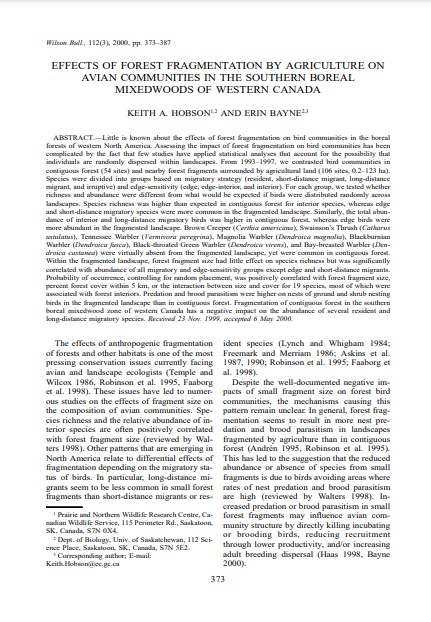Effects of Forest Fragmentation by Agriculture on Avian Communities in the Southern Boreal Mixedwoods of Western Canada
Bosque Modelo:
Prince Albert
Temática:
Gestión forestal
Tipo de documento:
Artículo científico
Resumen
Little is known about the effects of forest fragmentation on bird communities in the boreal forests of western North America. Assessing the impact of forest fragmentation on bird communities has been complicated by the fact that few studies have applied statistical analyses that account for the possibility that individuals are randomly dispersed within landscapes. From 1993–1997, we contrasted bird communities in contiguous forest (54 sites) and nearby forest fragments surrounded by agricultural land (106 sites, 0.2–123 ha). Species were divided into groups based on migratory strategy (resident, short-distance migrant, long-distance migrant, and irruptive) and edge-sensitivity (edge, edge-interior, and interior). For each group, we tested whether richness and abundance were different from what would be expected if birds were distributed randomly across landscapes. Species richness was higher than expected in contiguous forest for interior species, whereas edge and short-distance migratory species were more common in the fragmented landscape. Similarly, the total abundance of interior and long-distance migratory birds was higher in contiguous forest, whereas edge birds were more abundant in the fragmented landscape. Brown Creeper (Certhia americana), Swainson’s Thrush (Catharus ustulatus), Tennessee Warbler (Vermivora peregrina), Magnolia Warbler (Dendroica magnolia), Blackburnian Warbler (Dendroica fusca), Black-throated Green Warbler (Dendroica virens), and Bay-breasted Warbler (Dendroica castanea) were virtually absent from the fragmented landscape, yet were common in contiguous forest. Within the fragmented landscape, forest fragment size had little effect on species richness but was significantly correlated with abundance of all migratory and edge-sensitivity groups except edge and short-distance migrants. Probability of occurrence, controlling for random placement, was positively correlated with forest fragment size, percent forest cover within 5 km, or the interaction between size and cover for 19 species, most of which were associated with forest interiors. Predation and brood parasitism were higher on nests of ground and shrub nesting birds in the fragmented landscape than in contiguous forest. Fragmentation of contiguous forest in the southern boreal mixedwood zone of western Canada has a negative impact on the abundance of several resident and long-distance migratory species
Información Bibliográfica
Autor:
Hobson, KA and EM Bayne.
Revista:
The Wilson Bulletin
Año:
2000
N°:
3
País :
Canadá
Páginas:
373 - 387
Volumen:
112
Idioma:
Ingles
Palabras claves
Model forest, Adaptatation, Canada





